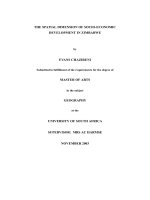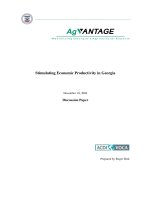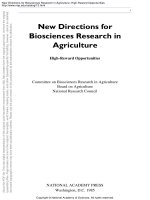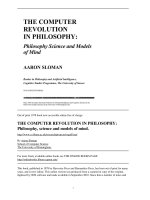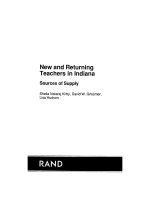Probiotic in Animals docx
Bạn đang xem bản rút gọn của tài liệu. Xem và tải ngay bản đầy đủ của tài liệu tại đây (13.05 MB, 284 trang )
PROBIOTIC IN ANIMALS
Edited by Everlon Cid Rigobelo
Probiotic in Animals
Edited by Everlon Cid Rigobelo
Contributors
Yunior Acosta Aragón, Everlon Cid Rigobelo, Fernando Antonio de Ávila, José Maurício
Schneedorf, Oscar M. Laudanno, Renata Ernlund Freitas de Macedo, Sérgio Bertelli Pflanzer,
Carolina Lugnani Gomes, Rafael Vieira de Azevedo, Luís Gustavo Tavares Braga, Frédérique
Chaucheyras-Durand, Eric Chevaux, Cécile Martin, Evelyne Forano, Gabriela Zárate, Luciana
Kazue Otutumi, Marcelo Biondaro Góis, Elis Regina de Moraes Garcia, Maria Marta Loddi,
María del Carmen Monroy Dosta, Talía Castro Barrera, Francisco J. Fernández Perrino, Lino
Mayorga Reyes, Héctor Herrera Gutiérrez, Saúl Cortés Suárez, Etleva Delia, Myqerem Tafaj
,
Klaus Männer
Published by InTech
Janeza Trdine 9, 51000 Rijeka, Croatia
Copyright © 2012 InTech
All chapters are Open Access distributed under the Creative Commons Attribution 3.0 license,
which allows users to download, copy and build upon published articles even for commercial
purposes, as long as the author and publisher are properly credited, which ensures maximum
dissemination and a wider impact of our publications. After this work has been published by
InTech, authors have the right to republish it, in whole or part, in any publication of which they
are the author, and to make other personal use of the work. Any republication, referencing or
personal use of the work must explicitly identify the original source.
Notice
Statements and opinions expressed in the chapters are these of the individual contributors and
not necessarily those of the editors or publisher. No responsibility is accepted for the accuracy
of information contained in the published chapters. The publisher assumes no responsibility for
any damage or injury to persons or property arising out of the use of any materials,
instructions, methods or ideas contained in the book.
Publishing Process Manager Petra Nenadic
Typesetting InTech Prepress, Novi Sad
Cover InTech Design Team
First published September, 2012
Printed in Croatia
A free online edition of this book is available at www.intechopen.com
Additional hard copies can be obtained from
Probiotic in Animals, Edited by Everlon Cid Rigobelo
p. cm.
ISBN 978-953-51-0777-4
Contents
Preface IX
Chapter 1 The Use of Probiotic Strains as Silage Inoculants 1
Yunior Acosta Aragón
Chapter 2 Protective Effect of Probiotics Strains in Ruminants 33
Everlon Cid Rigobelo and Fernando Antonio de Ávila
Chapter 3 Kefir D’Aqua and Its Probiotic Properties 53
José Maurício Schneedorf
Chapter 4 Indomethacin – Induced Enteropathy
and Its Prevention with the Probiotic Bioflora in Rats 77
Oscar M. Laudanno
Chapter 5 Probiotic Meat Products 85
Renata Ernlund Freitas de Macedo, Sérgio Bertelli Pflanzer
and Carolina Lugnani Gomes
Chapter 6 Use of Probiotics in Aquaculture 103
Rafael Vieira de Azevedo and Luís Gustavo Tavares Braga
Chapter 7 Use of Yeast Probiotics in Ruminants: Effects and
Mechanisms of Action on Rumen pH, Fibre Degradation,
and Microbiota According to the Diet 119
Frédérique Chaucheyras-Durand, Eric Chevaux,
Cécile Martin and Evelyne Forano
Chapter 8 Dairy Propionibacteria: Less Conventional Probiotics
to Improve the Human and Animal Health 153
Gabriela Zárate
Chapter 9 Variations on the Efficacy of Probiotics in Poultry 203
Luciana Kazue Otutumi, Marcelo Biondaro Góis,
Elis Regina de Moraes Garcia and Maria Marta Loddi
VI Contents
Chapter 10 Bacteria with Probiotic Capabilities Isolated
from the Digestive Tract of the Ornamental
Fish Pterophyllum scalare 231
María del Carmen Monroy Dosta, Talía Castro Barrera,
Francisco J. Fernández Perrino, Lino Mayorga Reyes,
Héctor Herrera Gutiérrez and Saúl Cortés Suárez
Chapter 11 Efficiency of Probiotics in Farm Animals 247
Etleva Delia, Myqerem Tafaj
and Klaus Männer
Preface
Probiotics are specific strains of microorganisms, which when served to human in
proper amount, have a beneficial effect, improving health or reducing risk of get sick.
The use of probiotics strains in animals production may reduces several problems
caused by antibiotics therapy, growth promoter and problems from inadequate
management.
This book comprehensively reviews and compiles information on probiotics strains in
11 chapters which cover the use of probiotics in several areas as silage inoculants,
protective effect in ruminants and the use of yeast, meat products, aquaculture,
poultry, ornamental fish and relevant discussions about the of kefir a`aqua properties
on animals.
This book is written by authors from America, Europe and Asia, yet, the editor has
tried arrange the book chapters in a issue order to make it easier for the readers to find
what they need. However, the reader can still find different approaches on probiotics
use in animals.
The scientists selected to publishing of this book were guests due to their recognized
expertise and important contributions on fields in which they are acting. Without these
scientists, their dedication and enthusiasm the publishing this book would have not
been possible. I recognize their efforts in the attempt to contribute to animals
production contributing thus to the developing Human and I´m very gratefully for
that.
This book will hopefully be of help to many scientists, doctors, pharmacists, chemicals
and other experts in a variety of disciplines, both academic and industrial. It may not
only support research and development, but also be suitable for teaching.
I would like to thank Professor Fernando Antonio de Ávila by his life lessons and also
by he to be my scientific mentor.
Finally, I would like to thank my daughter Maria Eduarda and my wife Fernanda for
their patience and also my son that is coming and in this moment is inside of
X Preface
comfortable womb. I extend my apologies for many hours spent on the preparation of
my chapter and the editing of this book, which kept me away from them.
Prof. Dr. Everlon Cid Rigobelo
Laboratory of Microbiology & Hygiene,
UNESP Univ Estadual Paulista
Animal Science Course
Dracena
Brazil
Chapter 1
© 2012 Aragón, licensee InTech. This is an open access chapter distributed under the terms of the Creative
Commons Attribution License ( which permits unrestricted use,
distribution, and reproduction in any medium, provided the original work is properly cited.
The Use of Probiotic Strains as Silage Inoculants
Yunior Acosta Aragón
Additional information is available at the end of the chapter
1. Introduction
To secure the health and good performance of animal husbandry, animals need a constant
supply of high quality nutrients the whole year round. The preservation of feed for use
during periods of underproduction is a universal problem. All farmers worldwide face the
challenge of guaranteeing feed for their animals throughout the year, and not only in terms
of quantity but also quality [1, 2].
Thus, a major concern of any farm that seeks to operate economically is the need to preserve
the quality of feedstuffs. On-farm feed preservation plays an important role in maintaining
the nutritive value of feed while avoiding losses caused by micro-organisms and
contamination with undesirable toxins, for instance, mycotoxins. Grain prices have risen
steadily due to poor harvests in key producing countries, supply constraints in rice-growing
economies and fast-growing demand for bio-fuel [3]. A price decrease is not expected in the
coming years. This is one of the reasons why producers have to maximise animal
performance by using locally produced feedstuffs that are found in abundance, such as
pastures, silages and industrial by-products.
The preservation of feed value is an important topic for animal performance. The aim is to
inhibit the growth of undesirable micro-organisms and the spoilage of the feedstuffs while
minimizing nutrient and energy losses.
A common technique used to preserve feed involves manipulating the presence or lack of
oxygen. Grains and hay are usually preserved aerobically with the addition of different
preservatives. Ensiling is a classic example of an anaerobic preservation technique.
The practice of ensiling was originally a management tool used mainly in ruminant
production to fulfill feed demand by storing and preserving any excess feed resources from
periods of overproduction for later use during periods of lack. However, its importance has
been increasing, especially in high input “zero-grazing” systems that enhance productivity
Probiotic in Animals
2
per animal per area unit [4-6]. Today, silage is the world’s largest fermentation process, with
an estimated 287 million tons produced in the EU alone [2].
Ensiling is a process in which lactic acid bacteria (LAB) convert sugars into mainly lactic
acid and other by-products, such as acetic or butyric acid [7], under anaerobic conditions.
This decreases the pH value, keeps the feed value, inhibits the growth of undesirable micro-
organisms, and preserves forages for long periods of time under normal conditions of up to
one to two years and even more. Though ensiling is used mainly to preserve voluminous
feed, many other substrates including grains, by-products like fish residues, wet distillery
grains with solubles or WDGS and brewer´s grains can also be ensiled.
The major advantages of silage are:
a. that crops can be harvested almost independent of weather conditions,
b. harvesting losses are reduced and more nutrients per area are harvested, and
c. ensiling permits the use of a wide range of crops [8, 9].
The necessary pre-requisites for the ensiling of any material are:
a. easily fermentable sugars (Water Soluble Carbohydrates, WSC),
b. anaerobic conditions,
c. lactic acid bacteria (LAB) and
d. factors allowing their proliferation like dry matter (DM) content and buffer capacity.
The DM content plays a huge role in the fermentability of a substrate. This key point seems
to be easy to guarantee but under practical conditions, is actually not. Due to different
weather conditions, it is a real challenge to harvest crops with adequate DM content.
On the other hand, bacteria, and specifically lactic acid bacteria originating from the
epiphytic microflora or silage inoculants, are able to survive only under specific conditions.
One such condition is the DM content, as it determines the osmotic pressure and the aw-
value of the substrates.
The ensiling process can be divided into four main phases:
1. Aerobic phase: This refers to the respiration and proteolysis by the plant’s own
enzymes. This can be reduced by optimizing particle length and proper compacting of
the material (Picture 1). This phase takes about three days under normal ensiling
conditions.
2. Fermentation: This refers to the acidification caused mainly by lactic acid produced by
lactic acid bacteria (LAB). This phase takes two to three weeks. Under anaerobic
conditions, lactic acid bacteria produce considerable amounts of lactic acid and the pH
decreases, inhibiting the growth of undesirable micro-organisms (especially Clostridia
and Enterobacteria). LAB ferments the substrate homofermentatively (only lactic acid) or
heterofermentatively (lactic acid + acetic acid). However, LAB represent only between
0.1 to 1.0 % of the normal epiphytic microflora. Therefore the use of bacterial inoculants
to secure the fermentation has increased in recent years.
The Use of Probiotic Strains as Silage Inoculants
3
Picture 1. Compacting of corn whole plant for silage in a South African farm (Y. Acosta Aragón)
3. Stable phase: Fermentation ceases due to a lack of carbohydrate substrates, and the pH
remains constant, depending on the anaerobic conditions created.
4. Feed out phase: Once the silo is opened and during feeding, portions of the silage are
exposed to oxygen (Picture 2). Aerobic micro-organisms, primarily yeasts and molds,
will grow, consume dry matter (sugar, lactic acid and other chemical substances), and
cause heating and high losses (CO
2 and H2O). This phase is decisive because the
nutrient losses could be considerably high. Aliphatic short chain acids (acetic, propionic
and butyric acid) [10] inhibit the growth of yeasts and molds and that is why biological
inoculants containing heterofermentative bacteria are used. The response to additives
depends not only on the forage to be treated, but also the dry matter (DM) content [11],
sugar content, and buffering capacity of the original material [12]. The characteristics of
inoculants include a rapid growth rate (to compete with other micro-organisms),
tolerance of low pH, ability to reduce pH quickly, non-reactivity towards organic acids,
tolerance towards a wide temperature range, ability to grow in high DM materials,
absence of proteolytic activity and an ability to hydrolyze starch.
In recent years, producers have begun to pay more attention to silage additives, [13] which
have been the focus of a tremendous amount of research over the last 20 years. Some of this
research has focused on increasing the nutritional value of silage by improving fermentation
Probiotic in Animals
4
so that storage losses are reduced, and increasing the aerobic stability of silage after the
opening of silos [14].
Picture 2. Silage after the opening of the silo under Brazilian conditions (Y. Acosta Aragón)
2. Silage microbiology
Silage making is based on microbiology. Silage inoculants are additives containing LAB that
are used to manipulate and enhance fermentation in silages like grass, alfalfa, clover and
other silages, as well as aerobic stability (mainly in corn silage). The most common LAB in
commercial inoculants is Lactobacillus plantarum and other Lactobacilli, followed by Enterococci
(for instance, E. faecium) and some Pediococci [15]. The main criteria for their selection are:
- high production of lactic and/ or acetic acid
- above all, quick growth in the first phase of the ensiling process in order to inhibit
undesirable micro-organisms
- high osmotolerance
- fermentation under technical conditions
- no antibiotic resistances
One the most important classifications of the LAB is according to whether their influence on
the ensiling process is homo- or heterofermentative. Homofermentative LAB produce
The Use of Probiotic Strains as Silage Inoculants
5
mainly lactic acid (more than 90% of the whole fermentation products) with energy losses
close to zero. On the other hand, heterofermentative LAB use WSC not only to produce
lactic acid but also acetic or propionic acid, ethanol, mannitol, etc.
The philosophy behind the first silage inoculants at the end of the 80s was that, in order to
achieve good results in the ensiling process, the substrate needs to acidify very deeply and
quickly. Since the drop in pH value is highly correlated (r
2
from -0.8 to -0.9) with the lactic
acid content, a major goal was to increase the amount of lactic acid through the use of
homofermentative LAB. However producers and researchers very soon found that the best
fermented silages often showed a worsened aerobic stability after the opening of the silo.
Those aerobic instabilities, reflected in heating and energy losses, are caused mainly by
yeasts. Yeasts are aerobic, mostly unicellular, eukaryotic micro-organisms classified as
fungi, which convert carbohydrates to CO
2 and alcohols, mainly ethanol. It is a metabolic
exothermic process with an energy loss of approx. 40 %. However, yeasts are sensitive to
short-chain organic acids like acetic and propionic acids. This was the reason for the start of
the use of heterofermentative LAB to prevent aerobic silage instability.
Picture 3. Listeria monocytogenes (iStock_000002507254Large©Sebastian Kaulitzki)
The main harmful micro-organisms present in silages are microbes with different
characteristics (classification, physiology, pathogenesis, detection, epidemiology, routes of
Probiotic in Animals
6
infection, infectious cycles, etc.) [16]. Good agricultural practices can help to prevent
infections transmitted by the ingestion of contaminated silages.
Listeria monocytogenes: These are gram-positive bacterium that can move within
eukaryotic cells (Picture 3). Clinical symptoms, such as meningoencephalitis, abortions and
mastitis in ruminants, are frequently recognized by veterinarians. The bacterium lives in the
soil and in poorly made silage, and is acquired by ingestion. It is not contagious; over the
course of a 30-year observation period of sheep disease in Morocco, the disease only
appeared in the late 2000s when ensiled feed-corn bags became common. In Iceland, the
disease is called silage sickness [17]. L. monocytogenes usually cannot survive below pH 5.6,
but in poorly consolidated silage with some oxygen, it may survive at pH levels as low as
3.8. As these conditions also favor the growth of certain molds, moldy silage generally
presents a high risk of listeriosis [18].
Clostridia: These are gram-positive obligate anaerobic bacterium that can form spores
(Picture 4).
Picture 4. Clostridia (iStock_000008522722XLarge©Sebastian Kaulitzki)
Crops for ensiling are often harvested in relatively wet conditions and have a low dry
matter content (<25 %). This presents a risk of contamination with Clostridia, which
The Use of Probiotic Strains as Silage Inoculants
7
increases the nutrient (protein) losses in silages and causes fermentation to butyric acid.
Another important consequence is that animals may reject silage due to its low palatability.
Clostridia can be prevented by a rapid and sudden pH decrease (pH below 4.5) [19].
Entereobacteria (coli forms): These are gram-negative, non-spore forming, facultative
anaerobes (Picture 5). They commonly enter silages from slurry, manure and soil in the early
stages of fermentation and convert the water-soluble carbohydrates into acetic acid, ethanol,
CO
2, and ammonia, resulting in high energy losses [20]. Their growth is reduced by
anaerobiosis, low pH values and fermentation acids. The optimal pH value for growth is
around 7; lower pH values markedly decrease the growth [20].
Picture 5. Enterobacteria (iStock_000003187348XLarge©Sebastian Kaulitzki)
Yeasts: These are eukaryotic unicellular aerobic micro-organisms (fungi) that use organic
compounds as a source of energy, mostly from hexoses and disaccharides, and do not
require sunlight to grow (Picture 6).
There are no known yeast species that only grow anaerobically (obligate anaerobes) [21].
Yeasts grow best in a neutral or slightly acidic pH environment. During the feed-out phase
in the absence of inhibiting substances like acetic and propionic acid, yeasts can grow very
rapidly and surpass 1 000 000 cfu/g silage, causing aerobic instability but also increasing the
Probiotic in Animals
8
Picture 6. Yeasts (iStock_000012250997XLarge©Dmitry Knorre)
Micro-organisms Author Year Statement
Saccharomyces rouxii
and Torulopsis
versatilis
Noda et al. [23] 1982
An increased toxic effect in brine
fermentation of soy sauce from pH 5.5
to 3.5
Candida krusei and
Pichia subpelliculosa
Danner et al. [24] 2003
Acetic acid has the greatest inhibitory
effect on yeast growth. 20 g liter
−1
of
acetic acid in the test mixture was
enough to completely inhibit the
growth of the selected yeasts at pH 4.
Silage yeasts
Driehuis and van
Wikselaar [25]
Oude Elferink
et al. [18]
1996
1999
High levels of formic or acetic acid
reduce survival during storage (in
silages)
Silage yeasts
Driehuis
et al. [26]
Oude Elferink
et al. [18]
1999
1999
Lactic acid is degraded anaerobically
to acetic acid and 1,2-propanediol,
which in turn causes a significant
reduction in yeast numbers
Table 1. Effect of acetic acid on different yeasts
risk of diarrhea in domestic animals. They compete with lactic acid bacteria for sugars,
which they ferment to create mainly ethanol. Ethanol has little (if any) preservative effect in
the silage but causes extremely dry matter and high energy losses of 48.9 and 0.2 %
The Use of Probiotic Strains as Silage Inoculants
9
respectively [20]. A level of acetic acid of 1.5 to 3.0 % in the dry matter could prohibit yeast
growth in silages exposed to air in the feed out phase [22]. However, higher levels diminish
the silage palatability. An overview of results in the scientific literature about inhibition of
yeast by acetic acid is presented in Table 1.
Molds: These grow in multicellular filaments and derive energy from the organic matter in
which they live, for example silages (Picture 7).
Picture 7. Molds in silages (Y. Acosta Aragón)
Mold spores can remain airborne indefinitely, live for a long time, cling to clothing or fur,
and survive extremes of temperature and pressure. Many molds also secrete mycotoxins
which, together with hydrolytic enzymes, inhibit the growth of competing micro-organisms.
The mycotoxins secreted can negatively affect the performance of domestic animals. Milk
contamination, decreased milk production, mastitis, laminitis, poor reproductive
performance and several gastrointestinal disorders are some of the effects on dairy cattle
which have been extensively described. The main mycotoxins found in silages were ZON,
DON and fumonisins [27] as well as roquefortine. The majority of fungi are strict aerobes
(require oxygen to grow) [28]; and only a few of them are micro aerobic (Mucor spp.) [29].
The main parameters for controlling the growth of the micro-organisms as described above
are summarized in Table 2.
Probiotic in Animals
10
Parameter Micro-organisms
Listeria
monocytogenes
Clostridia Enterobacteriae
Yeasts Molds
Nutrients
(Water-soluble
carbohydrates)
+++ +++ +++ +++ -
Anaerobiosis +++ - +++ +++ +++
pH* +++ +++ +++ - -
Lactic acid*
(fermentation)
+++ +++ +++ - -
Acetic acid* (feed out
phase)
+ + ++ +++ +++
Table 2. The control of harmful micro-organisms present in silages
- Low inhibition, + High inhibition. * Factors influenced by the use of silage inoculants
3. Use of probiotic strains in silages
Fermentation characteristics are generally improved with inoculation [30]. [31] reported that
inoculation improved fermentation characteristics in over 90% of 300 silages, including
alfalfa, wheat, corn, and forage sorghum silages. With any forage preservation technique,
the quantity and quality of material available at the end of storage is always below that of
the original. Thus, the primary goal of forage preservation is to minimize the spoilage and
losses of dry matter (DM) which will be reflected in the energy content of the silage, a
limiting factor for milk production.
Silage inoculants can be classified according to their effect on the ensiled matter or their
mode of action. The main effects of inoculants are:
a. to prevent undesirable fermentations and
b. to prevent silage spoilage during the feed out phase.
To achieve these effects, producers can utilize three different products or a combination of:
a. acids,
b. their salts and solutions respectively, and
c. biological silage inoculants.
Other silage additives with more limited uses than the above are molasses [32] and
enzymes. Salts and acids are used to cause an abrupt decrease in the pH value when the dry
matter content of the raw material is out of the optimal range. In cases of low dry matter
content, these products inhibit, above all, the growth of Clostridia. High dry matter content
very often means bad conditions for the compaction of raw materials; air stays inside the
ensiled matter, thereby hindering the anaerobic conditions required for good silage. The
advantage of the use of salts is that they are non-corrosive and easier and safer in
application compared with their corresponding acids.
The Use of Probiotic Strains as Silage Inoculants
11
Biological silage inoculants have been used and are established on the market because of:
a. their proven effectiveness in accelerating fermentation and improving aerobic stability,
b. higher recovery of dry matter and energy content compared with non-treated silages,
c. safety during usage and
d. relatively lower cost per treated ton compared with acids.
The quality of good biological silage inoculants must be selected, first, on the basis of the
included strains and their proportions in the product. Multi-strain inoculants have the
advantage of possibly using different sources of energy, with each strain having a different
desirable effect (rapid pH decrease, higher production of lactic acid, or acetic acid
production for a better aerobic stability). It is, therefore, possible to change the mode of
action of a product containing the same strains but with different proportions of the
bacterial strains. On the other hand, different strains of the same micro-organism will grow
faster on different substrates, temperature conditions or moisture content (osmotolerance).
Another aspect to take into account is the number of bacteria in the product and per gram of
silage. A review of the products existing on the silage additive market shows a variation of
100 000 to 1 000 000 cfu/ g of silage [33].
The effectiveness of a biological silage additive can be measured using different methods. It
is very difficult, under practical conditions, to measure success in terms of higher
performance (milk and/ or meat production) because the whole process is conditional upon
many factors. The first aspect to be taken into account is silage quality, worded in simple
parameters such as pH value, fermentation acids and energy content, compared with the
normal values for the ensiled crop or against a negative (no additive) or a positive (with
other additive) control.
In selecting the right biological silage additive, some pre-requisites, such as the crop to be
ensiled, should be taken into account. According to [33] there are three types of crops from
the point of view of “ensilability”, which are classified according to their fermentability
coefficient (FC):
FC = DM + 8 x (sugar content / puffer capacity)
The following criteria are used to interpret the FC values:
- poor ensilability (FC < 35)
- average ensilability(35 < FC < 45) and
- good ensilability (FC > 35)
For substrates of poor ensilability, the recommended biological silage additive should
contain (principally) homofermentative bacteria which produce mostly lactic acid. This
dramatically reduces the pH value (high negative correlation coefficient of more than 0.80
between lactic acid content and pH values). For substrates of good ensilability such as in
whole maize crop, the aim should be to increase the aerobic stability, because such
substrates are very rich in nutrients and spoil very quickly when in contact with air, and
Probiotic in Animals
12
therefore yeasts and molds [26, 34]. In the last case (improvement of aerobic stability),
biological silage additives with a higher ratio of heterofermentative bacteria are preferred
due to a higher production of acetic or propionic acid and the corresponding inhibition of
undesirable spoilage micro-organisms [35, 36]. Nevertheless the use of propionate-
producing propionic bacteria appears to be less suitable for the improvement of silage
aerobic stability, due to the fact that these bacteria are only able to proliferate and produce
propionate if the silage pH remains relatively high [37].
A real challenge for probiotic strains is the inoculation of haylage because of the high DM
content and the concomitant higher osmotic pressure. Very often, the term haylage is used
indistinctly and there are definitions which claim that “a round bale silage (a baleage) is also
sometimes called haylage“. [38] considered baleage, big bale haylage and round bale silage
as different names given to the same preserved feedstuff. Both processes are anaerobic but
the first one (haylage) is related to the DM content at ensiling; and the second one (baleage)
is the procedure used to protect the material against spoiling (baling, wrapping). That is the
reason why we fully agree with [8] when he writes “wrapped haylage bales”. Haylage may
be preserved wrapped but also in other type of silos (bunker, trench, etc.). Another
controversial topic is the right DM content range for haylage. A review on this topic is
shown in Figure 1.
Figure 1. Dry matter content of haylage according to different sources
The range varies from 35 to 60 % DM. Moreover, many companies produce haylage for
horses and consider it a special feed made of wilted grass silage with 65 % DM. In our
context, where we refer to the use of silage inoculants in haylage for cattle, we will consider
a range of 40 to 50 % DM, since anything below 40 % DM would be normal wilted silage.
Anything over this range (55 % DM) and the feed would be more suited to horses due to the
20
30
40
50
60
70
2008 2001 2004 2008 1988 2008 2003 2001 2001 2007
Merriam-WebsterKenney Schroeder Mayer Kent et al. PöllingerÁlvaro GarcíaClarke Wright Müller et al.
Dry matter (%)
Author (year)
The Use of Probiotic Strains as Silage Inoculants
13
higher fiber content (see Figure 1). Two very important aspects should be taken into account:
a) the high DM content is out of the optimal values for LAB and b) the material, due to the
high DM content, is difficult to compact.
The process of making haylage is the same as that for silage making, except that it takes
longer for wilting to reach the desired DM content. The advantages of the use of haylage
are:
- Free from spores and dust (very important for horses!)
- Lower storage losses than in silage making
- Weather independent compared with hay making
- Higher density of nutrients per volumetric unit compared with silages
Figure 2. Estimated hay and haylage harvest and storage losses (adapted from [43])
The storage and harvest losses with different moisture contents are given in Figure 2. Note
that total losses are minimized at a moisture level of between 50 and 60 % (40 to 50 % DM),
which represents a great advantage of the use of haylage. According to [39], the quality
parameters for haylage are not determined strictly enough. A major aim in haylage making
should be to reduce pH values to below 5, ideally below 4.5 to diminish the risk of botulism
[40] and listeriosis [41]. Since the DM is higher compared with that in silages, the production
of fermentation products will be lower. Common values for haylage containing lactic and
acetic acid would be from 15 to 50, and less than 20 g/ kg DM respectively. In haylage as in



